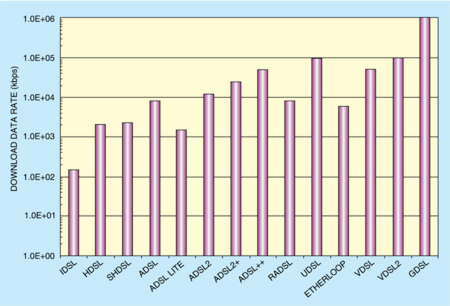ADSL++, another variant of ADSL, developed by Centillium Communications, is capable of providing download speeds up to 50Mbps, and uses the frequency band up to 3.75 Mhz.
Rate-adaptive digital subscriber line (R-ADSL). R-ADSL operates with the same transmission rates as ADSL, but the modem adjusts dynamically to varying lengths and quantities of the twisted-pair local lines. It makes possible to connect over different lines at varying speeds. Connection speed is negotiated by the end-points when the line synchronises up or as a result of a signal from the central office.

R-ADSL is designed to increase range and noise tolerance by sacrificing upstream speed. The modem automatically creates a greater frequency band for the downstream than the upstream band. If line noise or signal degradation is large, the upstream bandwidth is decreased and may fall up to 64 kbps, which is equal to the speed of ISDN.
Uni-digital subscriber line (UDSL). Uni-DSL technology was originally developed by Texas Instruments and is meant for one DSL for universal service. Thus all discrete multi-tone services can be provided from one line card or home gateway, which yields in ease of deployment and more affordability. Further, Uni-DSL is backward-compatible to ADSL, ADSL2, ADSL2+, VDSL and VDSL2. The aggregate downstream and upstream speed provided by UDSL is at least 200 Mbps.
Etherloop. Ethernet local loop is the next-generation DSL technology that incorporates the features of Ethernet and DSL. It is capable of delivering speeds up to 6 Mbps over a reach of 6.5 km on a moderate-quality copper line. Etherloop uses half-duplex transmission and is almost unaffected by interference caused by poor line quality. So it is possible to provide Internet services up to long distances. Etherloop modems can also be used as a LAN extension in a situation where direct Ethernet is not possible due to distance limitation.
Very high-speed digital subscriber line (VDSL). VDSL is the fastest xDSL technology over a single copper-pair wire, supporting downstream rates of 13 to 52 Mbps and upstream rates of 1.5 to 2.3 Mbps. It was standardised by ITU-T recommendation G.993.1 in November 2001. The standard VDSL specified both quadrature amplitude modulation (QAM) and discrete multi-tone (DMT) modulation systems. Seven different frequency bands are used in VDSL, which enable customisation of upstream and downstream data rates. Further, this technology provides a cost-effective alternative to fibre-to-the-home (FTTH). This asymmetric technology operates over 300 metres to 1.4 km only from the central office.
One method of VDSL deployment is to run a fibreup to an optical network unit in the neighbourhood and then run copper pair to the customer’s premises within 1.2 km of the optical network unit. The high bit rate support makes VDSL ideal for services like high-definition televiion (HDTV), as well as voice-over-Internet protocol (VoIP) and general Internet access.
In February 2006, ITU-T recommended discrete multi-tone for an advanced version of VDSL called ‘VDSL2’ and the recommendation was defined in G.993.2. This new and advanced version is capable of supporting triple-play services such as data, voice, video, HDTV and online gaming. Data rates of more than 100 Mbps simultaneously in both the downstream and upstream are achievable up to about 300 metres.
VDSL2 utilises bandwidth of up to 30 MHz. The performance greatly depends on the loop attenuation and degrades quickly from 250 Mbps at source to 100 Mbps at 0.5 km and 50 Mbps at 1 km. Its performance is equal to ADSL2+ for distances more than 1.6 km. ADSL-like long-reach performance is one of the key features of VDSL2.
Gigabit digital subscriber line (GDSL). Gigabit digital subscriber line technology is based on binder multiple-input and multiple-output (MIMO) technology. Channel matrices generated from a binder MIMO channel model use transmission methods that can yield more then 1Gbps symmetric data rates over four twisted pairs of copper wire for a 300m range. In practice, extra copper pairs exist (usually two to six pairs) in the final drop segment to connect a subscriber, but there is almost no extra copper pair (from drop point near the subscriber to central office)to connect all these pairs for each subscriber. So the information-carrying capacity of a fibrecan be exploited to connect back to central offie. Using this arrangement, all the unused copper pairs can be properly vectored and bonded to be treated as a single transmission path and can be utilised to provide high-speed data rates.
To sum up
DSL is drawing significantattention from service providers because it has the ability to deliver high-speed data transmission over existing infrastructure with relatively small changes. xDSL family of technologies provides data and voice services at the same time and on the same copper line, as it uses high-frequency bands for data services and low-frequency band for regular voice services. A comparison of downstream data rate offered by different DSL technologies is shown in Fig. 3.
The author is working with Bharat Sanchar Nigam Limited as a junior telecom officer and is currently posted at Ludhiana, Punjab. He holds PhD degree in electronics engineering from Indian Institute of Technology-BHU, Varanasi, India, and has authored and co-authored more than 25 research papers in peer-reviewed national/international journals including IEEE and conference proceedings






